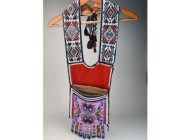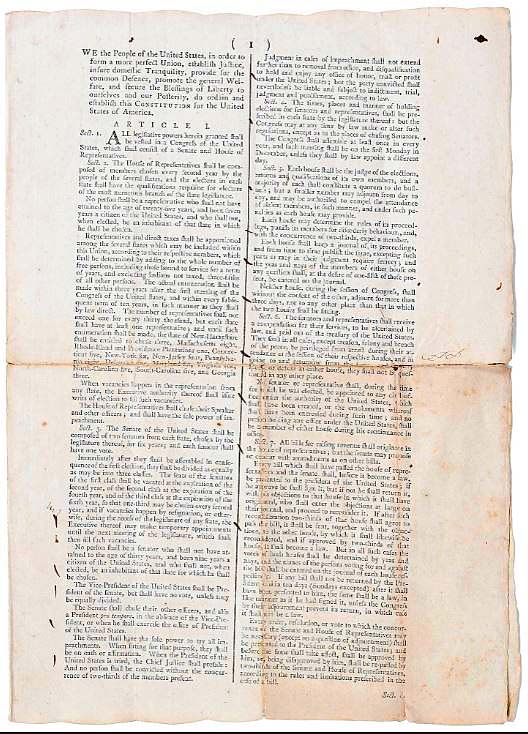
One of just 100 ever published and one of fewer than 10 known signed ratified copies of the Constitution, this printed archetype realized $11,070,000 from a private collector bidding on the phone. Andrew Brunk confirmed it had been offered without a published estimate but with an opening bid of $1 million.
Review by Madelia Hickman Ring
ASHEVILLE, N.C. — When Hurricane Helene devastated Western North Carolina in late September, it also upended the carefully laid plans by Andrew Brunk and his team. Among more than 600 lots of American and Southern fine and decorative arts was a selection of eight important American documents from a historic Edenton, N.C., family collection that also included a printed archetype of the Constitution valued at more than $1 million. The sale had been timed to coincide with the 237th anniversary of the September 28, 1787, printing of the Constitution, but Helene had other plans.
Andrew Brunk, speaking with Antiques and The Arts Weekly for the first time since the summer, shared some of the firm’s ordeal.
“When we lost connectivity that Friday [September 27], it was complete. We couldn’t text or call or email or access anything. We didn’t see all the images everyone else saw, so we didn’t know the level of destruction for about a week.”
“Covid was good training for us, when the team here showed their adaptability. In this case, we were able to come back as a team and offer each other support and camaraderie. Staying home was stressful so coming back — with generators and hotspots — was, in a way, good for our collective mental health. As a small business, we wanted to help restart the economic engine in Asheville. Part of it, too, was we wanted to hold on to the amazing excitement and press the Constitution had generated; we also had consignors counting on the sale.”
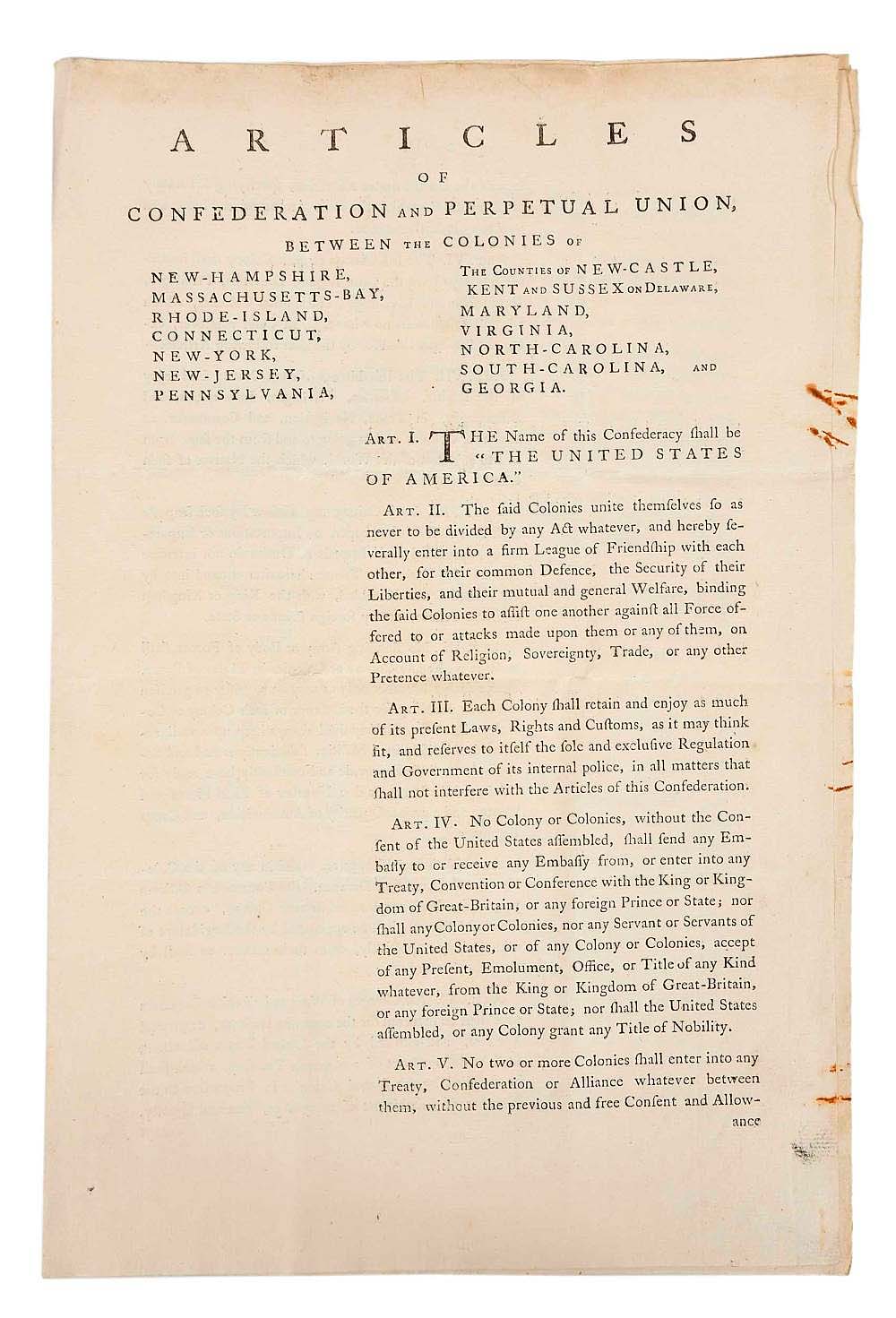
The only copy of the July 12, 1776, Articles of Confederation known to have come to auction came from the Edenton family collection and sold to a private collector, bidding on the phone, for $1,230,000 ($100/200,000).
“I’m incredibly proud of our team, as always, for stepping up and making it happen. I’m also really indebted to the arts, antiques and auction community at large: the outpouring of support was simply incredible. I can’t tell you the number of auctioneers and dealers and clients who offered assistance, from auctioneers in New York and New England to ones more local, it has been very uplifting. There’s a great silver lining in seeing that, in a moment of crisis, there are a lot of people ready to jump in and help. FEMA and the Red Cross are here, but we also have had a lot of people come through with four-wheelers and chainsaws to help us get through this. It’s been both very heartbreaking and heartwarming.”
The firm, which fortunately sustained no physical damage to any of its buildings, pivoted and rescheduled the auctions for Wednesday and Thursday, October 16 and 17. Led on the first day by 419 lots of American and Southern fine and decorative arts, it was followed the next day by 209 lots of important historic Americana, including furniture from the collection of renowned collectors, Dudley and Constance Godfrey. The evening of the second day provided the culmination of the two-day event, when eight documents and a copy of Emmanuel Leutze’s “Washington Crossing the Delaware” were offered. The last lot of all — the rare official signed ratification copy of the Constitution and the only known privately held example — achieved a triumphant conclusion to the sale, earning $11,070,000 and selling to a private collector bidding on the phone. The result set new records for the firm — both in terms of single-lot result and aggregate total — $17,298,167 with a 92 percent sell-through rate.
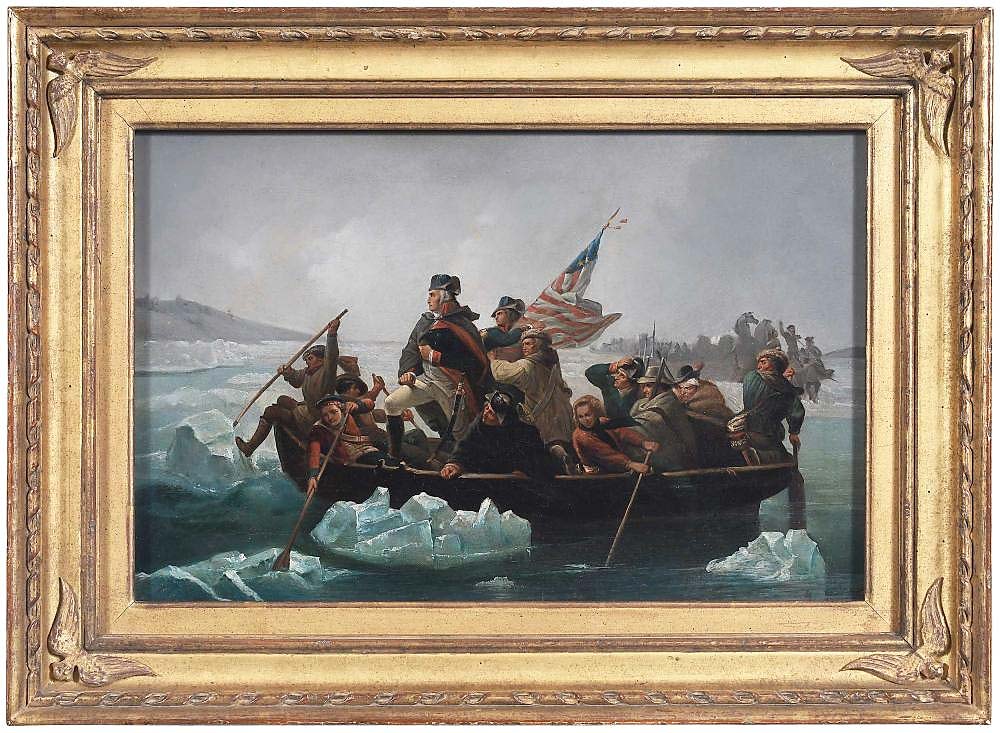
The penultimate lot in the evening session on October 17 was this 12-1/8-by-18-1/8-inch oil on canvas copy of “Washington Crossing the Delaware,” after Emmanuel Leutze’s 1851 monumental work. Estimated at $25/35,000, it sailed to $307,500, from a private collector bidding by phone.
The four-page folio printed archetype of the Constitution was from a run of just 100 copies printed on September 28, 1787, in New York City by John McLean for Dunlap and Claypoole of Philadelphia. According to the catalog, of the 100 copies originally printed by McLean, it is likely that only a fraction were signed by Charles Thomson, the Secretary of the Congress. Until now, only eight or nine of those signed copies were known to have survived the ages, with 1891 being the last time a signed ratification copy of the Constitution was offered at auction. The document had survived through generations at the historic Hayes Plantation in Edenton, N.C., which was owned by Samuel Johnston, Governor of North Carolina from 1787 to 1789 and who presided over North Carolina’s conventions where the Constitution was ratified.
“It was a landmark moment for us, for sure,” Brunk shared, who confirmed it had been discovered in a filing cabinet in a storage unit. “The journey with the Constitution started about a year ago and was a long process to make sure we dotted every ‘i,’ but it was a really memorable experience, and we’re obviously thrilled with the result, which is, to our knowledge, the second-highest auction record for an American document. It indicates the interest and strength in the market and, I hope, shines a light on the Constitution itself. As an auctioneer, when you look out at a big bank of phone bidders and know there are billionaires and household names, a ‘who’s who’ of many of the biggest players in the market, it’s a singular moment and really exciting. The buyer is extremely private and has chosen to remain anonymous for the time being, but it’s clear to us that they care deeply about the document and what it means. We are very confident that it went to a great new home.”
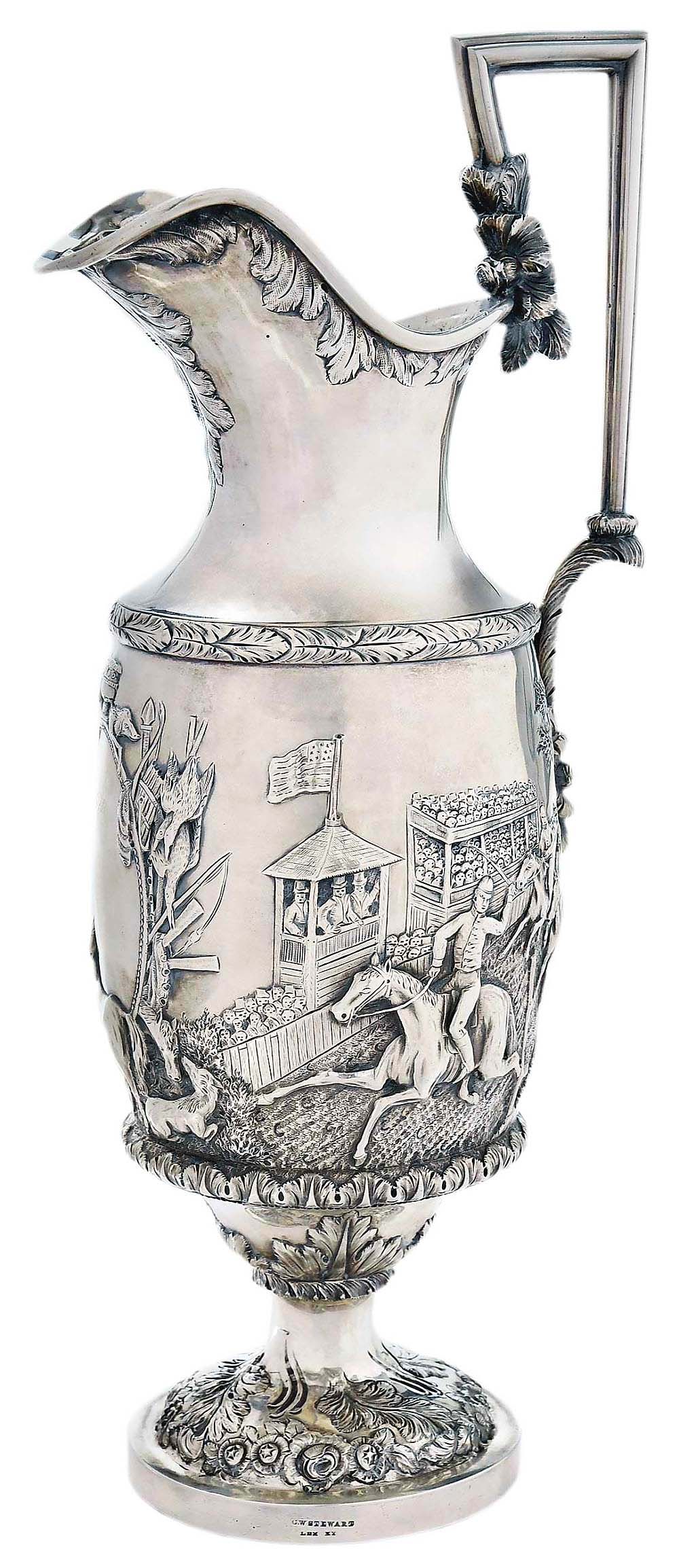
Inscribed “Red Bird,” who was sired by the premier Kentucky stud Grey Eagle, this coin silver horse trophy was made by Lexington, Ky., silversmith George W. Stewart, who is known to have made trophies or racing prizes, though few survive. Consigned to Brunk from a private collection, it rose to $221,400 and a new home with a private collector bidding on the phone. Andrew Brunk thought the result might be a record for Southern silver ($100/150,000).
On a personal level, Brunk was gratified that his father, Robert Brunk, who started the firm in 1983, was able to make it to the sale. His three children — sons Logan and Ellis, now both away at college, as well as daughter, Stella, still in high school in Asheville — were also in the salesroom to watch family history being made.
Brunk noted they’d seen a tremendous response to the other lots in the sale as well.
A seven-figure sum was also realized by a first draft of the Articles of Confederation and Perpetual Union Between the Colonies that was dated July 12, 1776, and which also sold to a private collector on the phone, for $1,230,000. It is the only known copy to have ever appeared on the market.
A survey map of North Carolina, drawn by Jonathan Price and John Strother and published in Philadelphia in 1807-08, that also came from the Edenton family collection, led the October 17 Important Historic Americana auction when it sold to a private collector, bidding online, for $418,200.
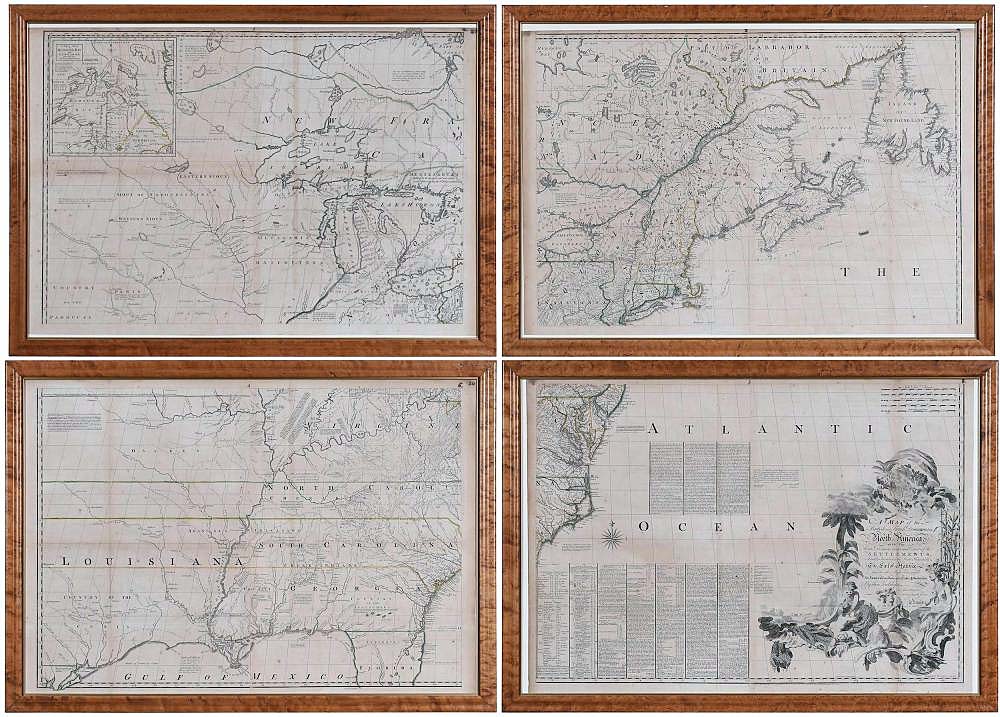
A trade buyer prevailed against competitors and won — for $92,250 — John Mitchell’s A Map of the British and French Dominions in North America ($50/70,000).
John Mitchell’s circa 1755-57 A Map of the British and French Dominions in North America that had been published in The Southeast in Early Maps by William Cumming (University of North Carolina Press, 1998) and Degrees of Latitude by Margaret Beck Pritchard and Henry G. Taliaferro (Colonial Williamsburg Foundation, 2002), also outperformed expectations at $92,250.
Achieving primacy in the American and Southern auction on October 16 was a coin silver horse trophy made by George W. Stewart in Lexington in the mid Nineteenth Century. Standing 14½ inches tall and related to another example that sold at Brunk Auctions in 2015 for $188,800, it did better, topped off at $221,400 by a private collector on the phone.
Brunk has been selling works from Godfrey and Constance Dudley’s collection of furniture and decorative arts since 2021 and the October 17 sale featured nearly two dozen lots of high-style American furniture made in Boston and Philadelphia, as well as the Delaware Valley and Connecticut. Soaring to $209,100 and a new home with a private collector was a William and Mary figured maple veneered high chest of drawers attributed to Theophilus Pickering and dated to circa 1725.
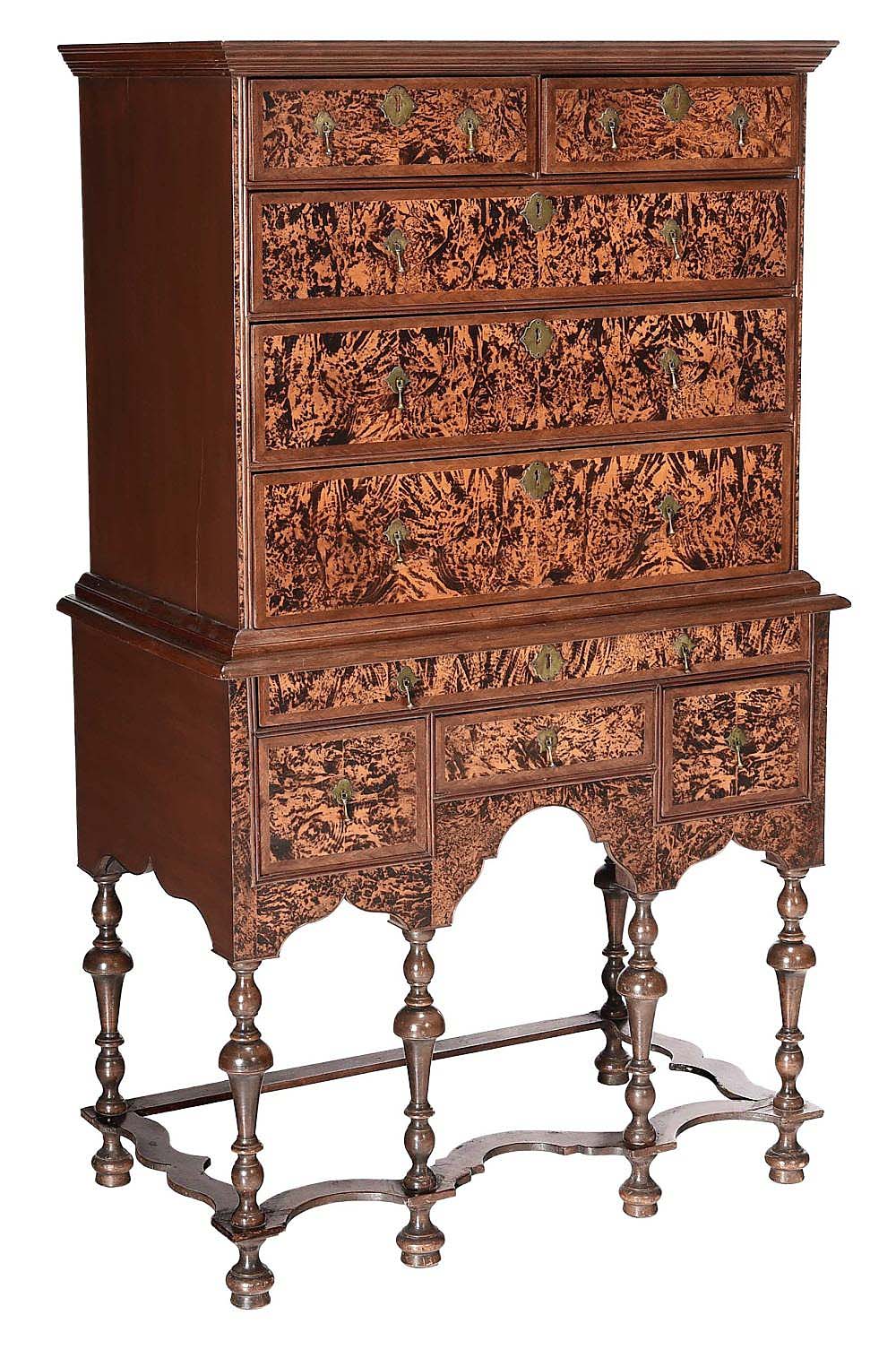
This William and Mary figured maple veneered high chest of drawers, attributed to Boston or Salem, Mass., circa 1725, that came to auction from the collection of Dudley and Constance Godfrey, traded for $209,100 and sold to a private collector on the phone ($40/60,000).
Highlights from the Godfrey collection also included a Connecticut Chippendale carved cherry chest from New London County ($86,100), a Philadelphia Queen Anne shell carved walnut easy chair ($86,100), a Salem, Mass., Chippendale walnut bonnet top high chest ($79,950) and a Philadelphia Chippendale carved mahogany pie crust table, attributed to the Wilkinson/Harding school and once owned by furniture scholar and advisor, Alan Miller ($41,820).
Southern furniture reached its apex on the first day, when a diminutive Federal desk on frame, made in Wilmington, N.C., circa 1895-1905, achieved $36,900. It was one of just two known examples and was documented in the files at the Museum of Early Southern Decorative Arts (MESDA). Also from North Carolina was a Federal inlaid walnut cellaret, attributed to Gates County cabinetmaker Joseph Freeman (1772-1842), that related to published examples and was topped off at $22,140.
An Assiniboine or Blackfoot painted hide war shirt, made in Montana in the late Nineteenth Century, had been sourced from an Aspen, Colo., private collection, exhibited at the Aspen Art Museum in 1999 and illustrated in two catalogs. Embellished with natural pigments, beadwork panels, ermine drops and red trade cloth, it achieved a second-place finish on the first day at $135,300.
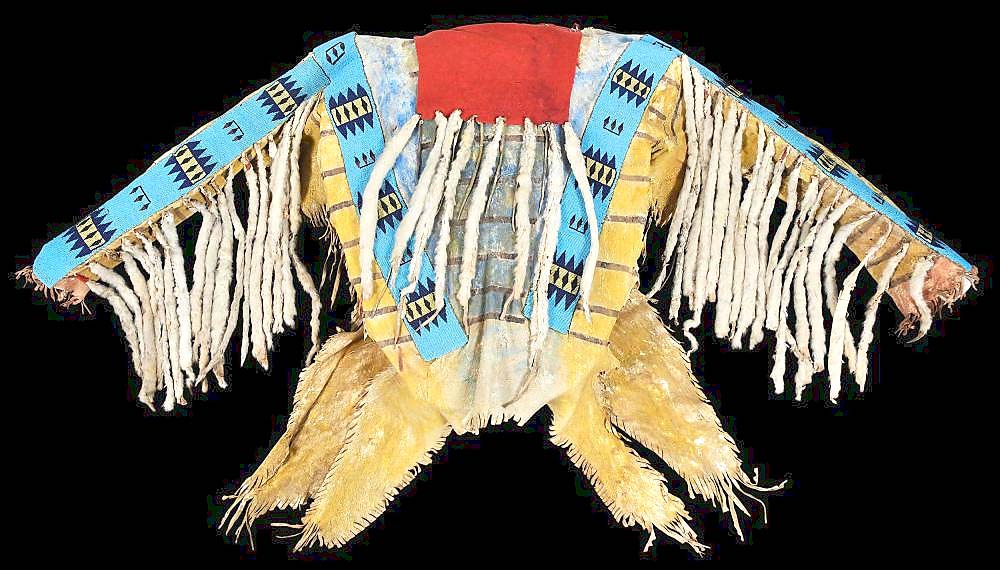
A private collector, bidding online, paid $135,300 for this Northern Plains painted hide war shirt that dated to the late Nineteenth Century ($30/50,000).
Native American interest was also represented in a mezzotint of Cunne Shote, a great warrior and chief of the Cherokee Nation. Engraved by James McArdell in London after Francis Parsons’ portrait, circa 1762, the piece achieved $51,660. An Eastern Sioux human effigy war club made in the Missouri Valley area made an impression with bidders and rose to $31,980, while a Kwakiutl polychrome wood mask depicting Bakwas, made in British Columbia in the early Twentieth Century, brought $18,450.
Fine art had several strong results, too. One the first day, an unsigned oil on canvas that depicted the Battle of Trafalgar and had history in the Fahnestock and Michalis families in New York state was attributed to Thomas Buttersworth, Jr. An international private collector, bidding online, beat out competitors to take it for $61,500. Works by Southern artists was set at $22,140 for Alice Ravenel Huger Smith’s “Moss Hung Tree,” a color woodblock.
Brunk Auctions will conduct a Photography and Luxury Goods sales on December 3, Jewelry and Timepieces on December 4, British & Continental Art & Antiques and Wine & Spirits on December 5 and American & Southern Art & Antiques on December 6.
Prices quoted include the buyer’s premium as reported by the auction house. For information, www.brunkauctions.com or 828-254-6846.






















